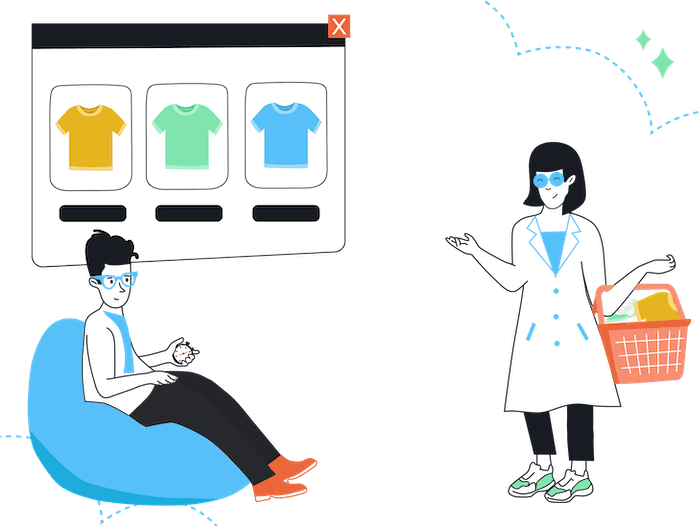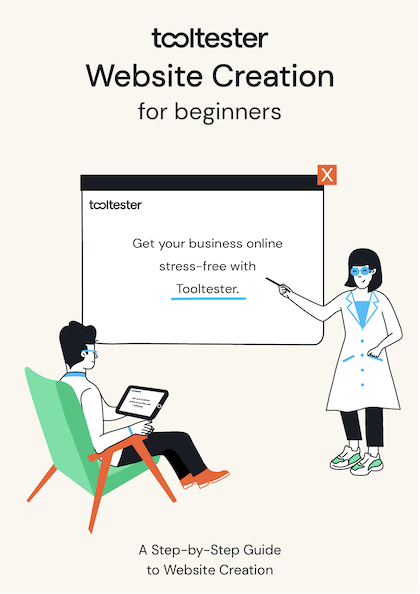If you’ve decided to open an ecommerce website, you might be wondering how long it ‘ll take to start making sales.
When I started building Unicorn Corner to sell unicorn horns online (yes, really!), I was dismayed when I read somewhere that an ecommerce website could take many months to build. I was surprised when it actually only took a few weeks.
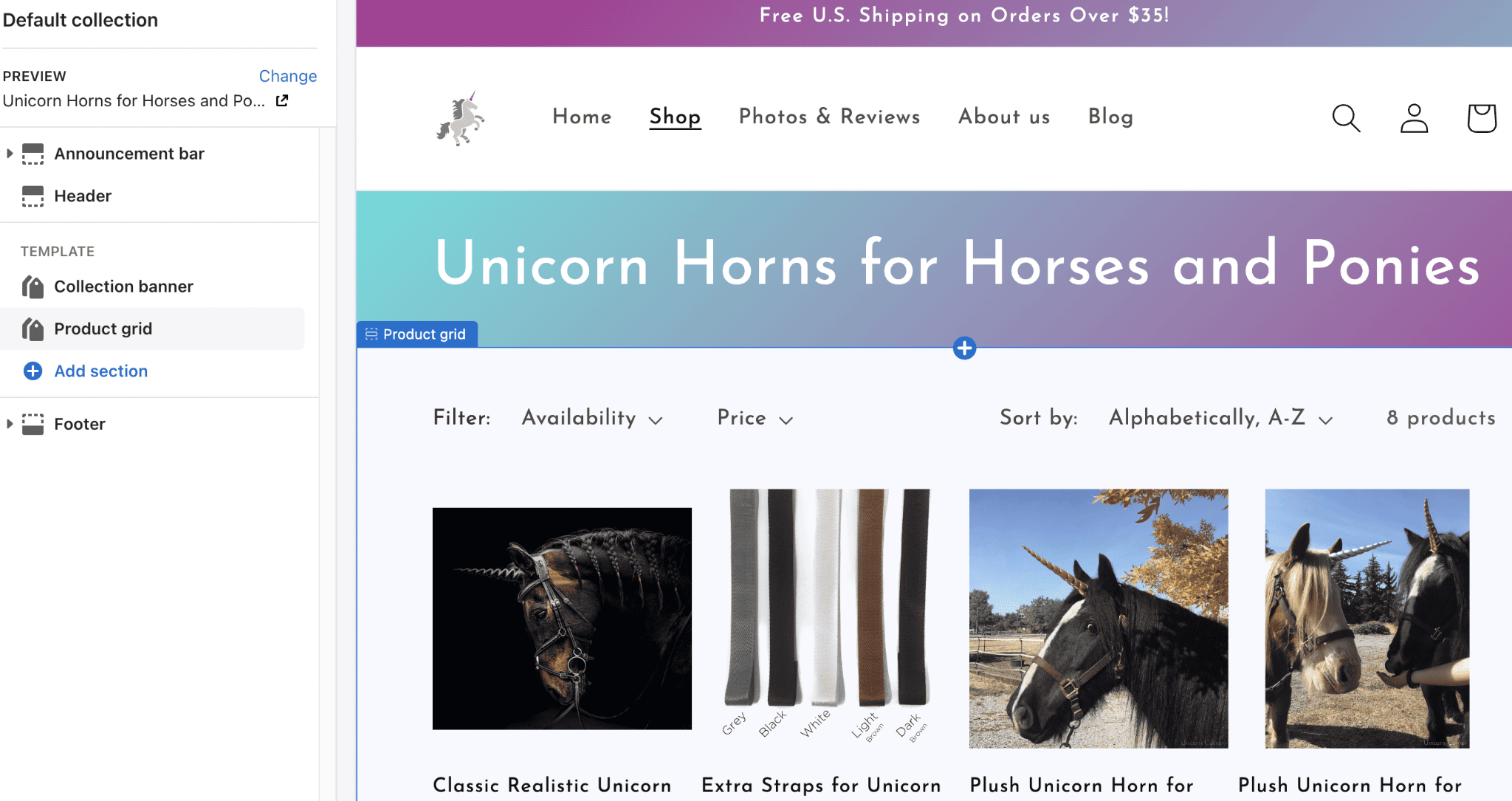
Unicorn Corner web store
Using a Shopify template, I was able to set up my shop quickly.
Of course, the time it takes to build a website varies greatly. But if you’re a small business owner like me, you probably aren’t looking for a highly complex, custom-coded website. You need something functional in order to start selling soon.
In this article, we’re going to take a look at real-world examples of build times for a variety of ecommerce shops. I’ll help you understand how the design complexity of your website will influence how long it takes to build. I’ll also give you a sense of what you can expect whether you’re working with a developer or doing it yourself.
To keep it simple, we’re going to be talking about ecommerce shops that are built with a website builder or an ecommerce platform. Using one of these tools will vastly reduce the time it takes to launch your store, as they don’t require any custom coding. There are tons of great options which we have reviewed here on Tooltester, and deciding which to use will be one of the first steps in building your ecommerce business.
Key Takeaways
1. Research and Preparation: 1 week – 3 months
Set a budget, develop product offerings and a marketing strategy
2. Website Design Planning: 1 week – 3 months
Select an ecommerce platform, plan the design, layout, and content
3. Building the Web Store: 1 day – 1 week
Upload content to your ecommerce platform
4. Testing and Launch: 1–3 days
Testing for security and functionality
If you’re short on time, here’s a quick spoiler: The first two phases are highly subjective and depend mostly on how quickly you make decisions. We estimate anywhere from one week to three months for each.
The building and testing phase is the actual website construction. Here, we calculate between one day to two weeks using a website builder or ecommerce platform. This is a realistic timeframe to create a functional online shop that meets the needs of most small business owners.
Now, let’s take a deep dive into all four phases of building your ecommerce website.
1. Research and Preparation
🕐 One Week to Three Months
Whether you’re building your online store yourself or hiring a developer, it is critical to do some basic research and preparation before starting. If you’re doing it yourself, being prepared will help you work more efficiently. If you’re working with a developer, you’ll be able to communicate a sense of your project’s scope and your vision for the final product.
The first step is to prepare the groundwork of your ecommerce shop. In many ways, this step isn’t much different than a business plan except now the focus is on translating these ideas into an ecommerce website. This phase of the process could take anywhere from one week to three months for most small businesses who are just getting started.
Here’s a breakdown of some of the things you should research in this time.
Set A Budget:
Your website can cost anywhere from $0 to ∞, but expect to pay around $300 per year to maintain a basic online store. Don’t forget to calculate other expenses like domain registration, web hosting, templates, and email accounts. We’ve created an in-depth guide on the costs of building a business website to better help you estimate your budget.
Develop Product Offerings:
Creating your product listings is a crucial step when you begin building your website. You should have a clear idea of pricing, packaging, and inventory management. If you’re still figuring out what you want to sell, we’ve done some research on finding the best product niches.
Hone Marketing Strategy:
It’s not necessary to have your marketing strategy completely figured out before you start building your ecommerce store. But you should think about who your target audience is, and how you can convert them into customers. This will impact decisions about your website design later.
2. Website Design Planning
🕐 One Week to Three Months
In this phase, you’re going to plan what you want your website to look like, as well as the features and functions that you want it to have. Here, we’ll give you a basic overview tailored to meet the needs of most sole proprietors and small business owners. If you’re ready for a more in-depth guide, check out our step-by-step guide to building a website.
Selecting A Platform
If you don’t want to code your entire site from scratch (who’s got time for that?) the first step in designing your website is to select a platform on which to build your shop.
Pro Tip: If you plan to get help building your website, we highly recommend choosing your platform first and then finding a developer who works with your selection. You might end up working with a different developer in the future, so make sure your platform meets your budget and needs regardless of who’s helping build your site.
Let’s take a quick look at the pros and cons of a few of our top choices for small businesses:
| Platform | Pros | Cons |
|---|---|---|
| Wix |
|
|
| Squarespace |
|
|
| Shopify |
|
|
If you’d like to read detailed reviews of these (and many other) options, we’ve got you covered.
Design, Layout, and Content
If you’re a creative type, this step is where the fun begins. Here, you’re going to start thinking about how you want your finished website to look. Start by saving examples of existing websites that inspire you (like these Shopify stores, for example). Then, look for a template on your chosen platform which provides a similar layout and navigation structure. If you’re working with a developer, you can ask them to find a template for you.
One of the most time-consuming steps in this process is gathering all the content that will make up your final website. Here’s a list of what you may need to prepare:
- Photos of your products
- Video content
- Logos and other branding images
- A color palette
- Fonts
- Website copy (all the text on your site, including product descriptions, labels, policies, etc)
Features and Functionality
Finally, think about any features or functions that your website will need. A basic ecommerce platform will provide the essentials, like a checkout funnel and payment processing. You will likely need to set up shipping and tax calculators based on your location.
You might need a feature that isn’t included. For example, I was surprised when setting up my website on Shopify that there was no way for customers to add photo reviews. Fortunately, website builders like those mentioned above provide extra functionality in the form of plugins or apps.
These allow your website to do something specific that it can’t do by default. If you need an extra feature, research the pricing and capabilities of a plugin or app, and calculate extra time for setup during the final website build.
3. Building the Web Store
🕐 One Day to Two Weeks
You’ve done your research and you have a good sense of what your website should do and how it should look. Now, you’re ready to build it! So, how long will it take?
In order to calculate how long it will take to build an ecommerce shop, we analyzed the services offered by 25 freelance web developers on Upwork. Each freelancer provided information about their services within three tiers of ecommerce website complexity: starter, standard, and advanced.
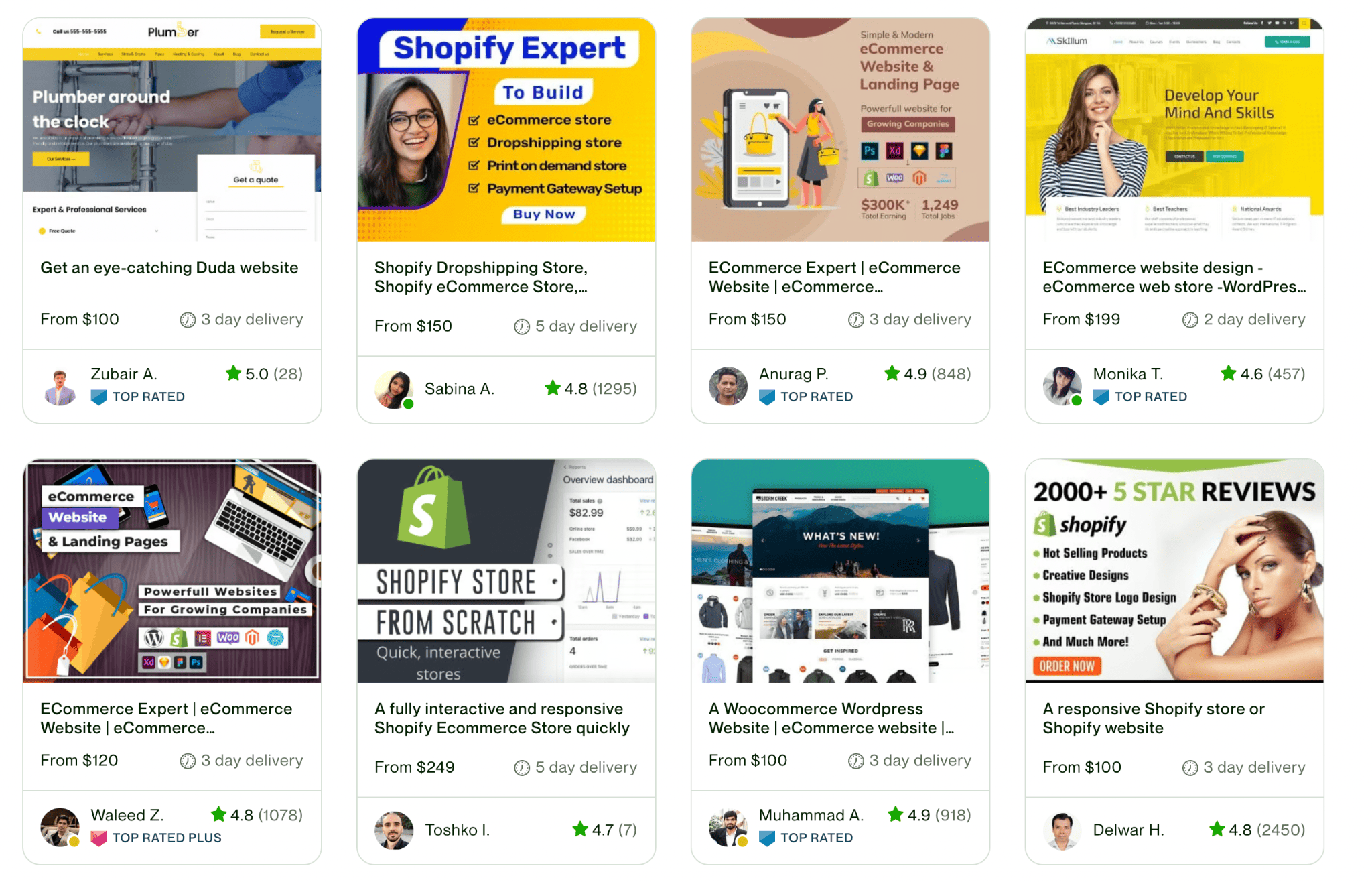
Upwork freelancers offer services for ecommerce website design using existing platforms
After crunching the numbers, we came up with average delivery times for each website tier. In my experience, working with a freelancer usually requires some changes after the initial deliverable, so I’ve added time for that revision process as well.
The results:
| Average Delivery Time | Revision Time | Pages Included | Products Included | |
|---|---|---|---|---|
| Starter | 3 days | ∼ 1 day | 3 | 5 |
| Standard | 6.5 days | ∼ 2 days | 5 | 10 |
| Advanced | 10 days | ∼ 4 days | 10 | 25 |
You might be surprised by how quickly many developers can get an ecommerce site ready for business. But remember, these are not custom-coded websites. These developers use web builders and ecommerce platforms, and they work from existing templates.
You’ll also notice that even the “advanced” tier only offers an average of 10 pages and 25 products, so really we’re looking at offers for micro to mid-sized ecommerce shops here.
It’s important to remember that these delivery times assume that you have done all the research and preparation mentioned in the previous sections. If you have to go back and forth with the developer to make decisions about style or content, the process will be longer and the price will be higher.
Doing It Yourself
So, we’ve seen the timeframes which freelance website developers estimate for setting up ecommerce shops. But what if you’re building your own website? How long is it going to take you to build your online shop?
If you use the right tools, it should take you about the same time as the average Upwork freelancer, in many cases even less. If you’ve never built a website before, expect to spend some time learning through trial and error. Select a platform which offers robust customer service, in case you get stuck and need some help.
To take a closer look at the build times of DIY ecommerce shops, I spoke to small business owners who built their own websites using different platforms. Here are their websites and some notes from the owner about how long it took to build each one.
| Website | Platform | Build Time | About the Build |
|---|---|---|---|
| Ayla Candles | Squarespace | 1 afternoon | Mar Gálvez built the Ayla Candles website in a single afternoon. She had experience with Squarespace from building her massage business website, which she also was able to set up quickly. |
| Pretty In Ink: Electric Tattooing | Squarespace | ∼7 hours total | Amy Muller set up the Pretty In Ink Electric Tattooing website in about 3 hours. During the Covid-19 lockdown when her tattoo shops closed, she spent about 4 hours converting the website into an ecommerce shop to sell art prints, stickers, and t-shirts. |
| Eat Your Soup | Weebly | 1 afternoon + 1 week | Yonah Forst built the initial Eat Your Soup website in an afternoon. After that, he spent about a week learning about what the platform could or couldn’t do, and continued to refine his shop’s design within those parameters. |
| Unicorn Corner
(my shop!) |
Shopify | ∼ 1 week | I spent about a week setting up my store in 2016. I had some previous experience with website builders such as GoDaddy and Squarespace. In 2022 I upgraded my shop theme, which took about 3 days and required a few help chats. |

Websites built by small business owners without the help of developers
4. Testing and Launch
The final step before launching your website is testing to make sure it is functional and secure. These steps can likely be accomplished in a few hours for a small ecommerce shop:
- Check all texts for spelling and grammatical errors
- Click all the links and make sure they are working
- Look at your website on different devices and check for responsiveness
- Add an SSL certificate to prevent your website from being labeled “not secure” (Shopify has an explainer here)
- Ensure your admin area is secured with a strong password, and preferably two-step authentication
A great way to do basic usability testing is by launching your site with a password. Send your friends and family the link and the password, and have them provide feedback. Then, simply remove the password and your site is ready to go!
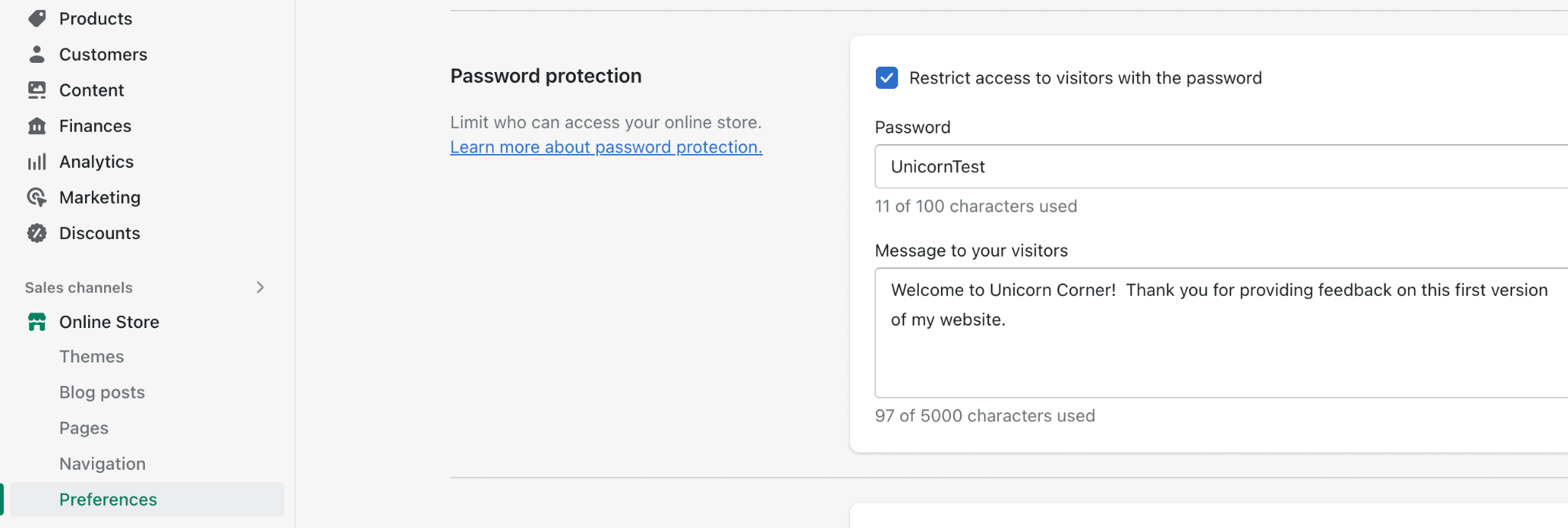
Shopify enables you to create a password for visitors to your store
Final Thoughts (and a pep talk)
No matter where you are in the process of setting up your ecommerce website, it’s possible to feel overwhelmed by the tasks ahead.
You shouldn’t launch your website unless it is functional, secure, and a good representation of your brand. However, it isn’t necessary to build the best website on the internet before saying “hello world”.
Successful businesses often start by building a minimal viable product, or MVP. The idea is simple: your first ecommerce site doesn’t have to be perfect, it just has to work. Improvements will come with every iteration.
I’ve been running my current ecommerce website since 2016 and I still don’t consider it a finished product. There’s always room for improvement, and tinkering is key. Don’t get overwhelmed by the details. Just start!
If you have any questions, please let me know in the comments!
THE BEHIND THE SCENES OF THIS BLOG
This article has been written and researched following a precise methodology.
Our methodology